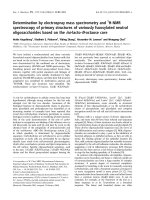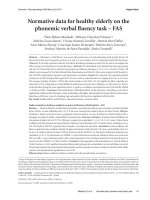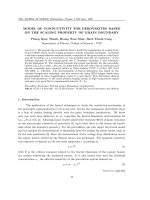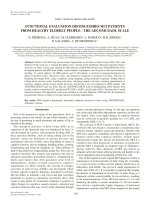Normative data for healthy elderly on the phonemic verbal fluency task – FAS doc
Bạn đang xem bản rút gọn của tài liệu. Xem và tải ngay bản đầy đủ của tài liệu tại đây (162.54 KB, 6 trang )
Dementia & Neuropsychologia 2009 March;3(1):55-60
Original Article
Machado TH, et al. Normative data: phonemic verbal fluency task 55
Normative data for healthy elderly on the
phonemic verbal fluency task – FAS
Thais Helena Machado
1
, Helenice Charchat Fichman
2,4
,
Etelvina Lucas Santos
1
, Viviane Amaral Carvalho
1
, Patrícia Paes Fialho
1
,
Anne Marise Koenig
1
, Conceição Santos Fernandes
3
, Roberto Alves Lourenço
5
,
Emylucy Martins de Paiva Paradela
6
, Paulo Caramelli
1
Abstract – Phonemic verbal fluency tests assess the production of words beginning with specific letters. Of
these letters, the most frequently used are F, A and S. It is a sensitive test for assessing frontal lobe functions.
Objective: To provide normative data for the elderly Brazilian population on the FAS test and to investigate the
effects of age and schooling on test performance. Methods: The individuals were divided into three age groups
(60–69, 70–79 and ≥80 years), and into four groups according to education (1–3, 4–7, 8–11 and ≥12 years). All
subjects were assessed by the Mini Mental State Examination and the FAS. Data were analyzed with Student’s t
test, ANOVA, simple linear regression and Spearman’s correlation. Results: We evaluated 345 cognitively healthy
volunteers, 66.66% being female, aged 60 to 93 years, with an educational level ranging from one to 24 years.
The average (number of items) ±SD for the whole sample was 28.28±11.53. No significant effect of gender was
observed (p=0.5). Performance on the MMSE and education exerted a direct influence on FAS scores (p<0.001),
with education being the most significant factor. A positive correlation was found between FAS and the MMSE
(r=0.404; p<0.001). Conclusion: The performance of Brazilian elderly on the phonemic verbal fluency tests-FAS is
significantly influenced by education, where individuals with higher educational level present better performance
than those with fewer years of schooling. Age and gender did not prove significant with the FAS.
Key words: healthy elderly, verbal fluency, educational status, normative data.
Dados normativos de idosos saudáveis na prova de fluência verbal fonêmica – FAS
Resumo – Testes de fluência verbal fonêmica avaliam a produção de palavras que se iniciam com determinadas
letras. Destas, as mais utilizadas são F, A e S. É um teste sensível para avaliar funções do lobo frontal. Objetivo:
Estabelecer dados normativos para a população idosa brasileira no teste de fluência verbal fonêmica FAS e
investigar os efeitos da idade e escolaridade no mesmo teste. Materiais e Métodos: Os sujeitos foram divididos em
três grupos de idade (60–69, 70–79 e ≥80 anos) e quatro de escolaridade (1–3, 4–7, 8–11, ≥12 anos). Todos foram
avaliados pelo Mini-Exame do Estado Mental e fluência verbal fonêmica FAS. Os dados foram analisados com o
test t de Student, ANOVA, regressão linear simples e correlação de Spearman. Resultados: Foram avaliados 345
idosos cognitivamente saudáveis, 66,66% do gênero feminino, idade entre 60 e 93 anos e escolaridade entre 01 e
24 anos. A média (número de itens) ±DP na amostra toda foi 28.28±11.53. Não houve influência do gênero nos
resultados (p=0.5). A performance no MEEM e o nível educacional exerceram influência direta nos escores do
FAS (p<0.001), com a educação sendo o fator mais importante. Uma correlação positiva foi encontrada entre os
escores no FAS e MEEM (r=0.404; p<0.001). Conclusão: O desempenho de idosos brasileiros no Teste de Fluência
Verbal Fonêmica – FAS é significativamente influenciado pelo grau de escolaridade, com os indivíduos com nível
educacional mais elevado apresentando desempenho superior àqueles com menos tempo de estudo formal. Idade
e gênero não apresentaram significância com o FAS.
Palavras-chave: idosos saudáveis, fluência verbal, nível educacional, dados normativos.
1
Grupo de Pesquisa em Neurologia Cognitiva e do Comportamento, Departamento de Clínica Médica, Faculdade de Medicina da UFMG; Ambulatório de
Neurologia Cognitiva do Hospital das Clínicas da UFMG, Belo Horizonte, MG, Brazil.
2
Departamento de Psicologia, Pontíficia Universidade Católica do
Rio de Janeiro, Rio de Janeiro, RJ, Brazil.
3
Laboratório de Pesquisa em Envelhecimento Humano - GeronLab, Universidade do Estado do Rio de Janeiro, Rio
de Janeiro, Brazil.
4
Departamento de Neurologia, Universidade de São Paulo, São Paulo, SP, Brazil.
5
Disciplina de Geriatria, Departamento de Medicina In-
terna, Faculdade de Ciências Médicas, UERJ, Rio de Janeiro, RJ, Brazil.
6
CIPI – UNATI, Universidade do Estado do Rio de Janeiro, Rio de Janeiro, RJ, Brazil.
Paulo Caramelli – Departamento de Clínica Médica da Faculdade de Medicina da Universidade Federal de Minas Gerais – Av. Prof. Alfredo Balena, 190
/ Sala 246 - 30130-100 Belo Horizonte MG - Brazil.
Disclosure: The authors reports no conflicts of interest.
Received January 15, 2009. Accepted in final form February 27, 2009.
Dement Neuropsychol 2009 March;3(1):55-60
56 Normative data: phonemic verbal fluency task Machado TH, et al.
The ageing process leads to anatomical and functional
alterations that influence the capacity of an individual to
adapt to the environment and also increase the incidence
of illnesses. In Brazil, demographic data from the past two
decades demonstrate a significant increase in life expec-
tancy associated with a decrease in birth rate, similar to the
pattern in developed countries over the last century.
1,2
The
high life expectancy causes an increase in the incidence of
neurodegenerative illnesses and makes the differentiation
between normal and pathologic ageing an important and
challenging task for the clinician.
3
The knowledge of alterations inherent to cognitive
functioning for instance, is an important parameter to dif-
ferentiate normal from pathological ageing. Therefore, it is
essential to have robust knowledge on cognitive domains,
as well as information on performance in specific tasks that
assess these domains.
4
Different cognitive domains are known to change dur-
ing the normal ageing process, including executive func-
tions. Some studies have shown changes in performance on
executive tests,
5-8
although there is still no consensus about
the nature of such alterations, for instance whether they
are primary or secondary to impairment in other cognitive
abilities, such as memory
9,10
or perceptual speed.
11
The term “executive functioning” refers to those abili-
ties that allow an individual to determine objectives, to
formulate new and useful strategies to reach these goals
and to follow, pursue and adapt according to the various
circumstances that he/she might deal with, frequently dur-
ing longs periods of time. The frontal lobes are considered
responsible for the decisive aspects of these abilities.
12-17
Several investigators
16,18,19
have proposed procedures
and instruments to assess executive functions, such as the
Wisconsin Card Sorting Test (WCST), Stroop Test, Clock
Drawing Test and Verbal Fluency.
There are two types of verbal fluency tasks: semantic
and phonemic. Semantic fluency tests require subjects to
say as many words as possible belonging to a certain cat-
egory (e.g. animals, fruits) whereas phonemic fluency tasks
require participants to say as many words as possible be-
ginning with a specific letter, usually within one minute. It
is a sensitive task for assessing frontal lobe functions, espe-
cially prefrontal left areas.
13,17,20-24
Both tests require neither
specific materials nor a long time to administer. The FAS
test is probably the best known phonemic fluency test, and
consists of saying words beginning with the letters F, A and
S, one at a time for one minute.
The FAS test is related to the frequency of words begin-
ning with each letter in each language. Considering that pho-
nemes may differ between languages, the scores of phone-
mic verbal fluency are not comparable from one country to
another.
22,23
Moreover, in Brazil there is a marked heterogene-
ity in educational level, mainly within the elderly population.
Some studies have shown correlations for age, school-
ing and gender with performance in phonemic and cat-
egory fluency tasks.
23,25-30
Considering these factors, it is
necessary to determine specific parameters for the Brazilian
population, which should take into account the influence
of the different demographic variables.
The goals of the present study are to provide norma-
tive data for the Brazilian population on the verbal fluency
test – phonemic tasks – FAS – in healthy elderly, and to
investigate the effects of age, schooling and gender on test
performance.
Methods
Sample
The sample consisted of cognitively healthy elderly,
who received outpatient care in university reference centers
from Belo Horizonte, São Paulo and Rio de Janeiro.
All subjects were aged 60 years or more, who attained
above education-adjusted scores on the Mini Mental State
Examination
31,32
(MMSE). The Brazilian version of the
MMSE used was the one proposed by Brucki et al.,
33
which
was applied according to the specific instructions provided
by these authors.
Additional inclusion criteria followed the recommen-
dations from the Mayo’s Older Americans Normative Stud-
ies
34
(MOANS): absence of active neurologic or psychiatric
disease; absence of cognitive deficit; absence of use of psy-
chotropic medication in quantities that can compromise
cognitive functioning or suggest neuropsychiatric pertur-
bation; independent life status; absence of previous history
of disorders that could influence cognition.
The subjects were divided into three age groups (60–69,
70–79 and 80 or more years) and into four groups accord-
ing to years of formal educational (1–3, 4–7, 8–11 and 12
or more years). Illiterate individuals were excluded.
Procedure
The participants were instructed to generate as many
words as possible beginning with letters “F’’, “A” and “S”
within a 1-minute period for each letter, excluding proper
nouns such as people’s, city and country names and the
same word with a different suffix. The following instruc-
tions were given: “I will say a letter of the alphabet. Then,
I want you to give me as many words you can that begin
with this letter, as quickly as possible. For example, if I say
B, you can say bed, big, but you can’t say proper nouns like
Brazil or Beatriz. Also you can’t say the same word with a
different ending”. Subsequently, the subjects were asked if
they had understood these instructions.
Dement Neuropsychol 2009 March;3(1):55-60
Machado TH, et al. Normative data: phonemic verbal fluency task 57
Words with one, or more than one meaning were also
considered, if the subject pointed out the alternative mean-
ing. Words in other languages that were included in the
Portuguese Dictionary and widespread words even if not
in the dictionary also counted. When the participant cor-
rected their response, this was not considered an error. The
final score only included correct answers.
The following items were considered errors: intrusions
(i.e.: when appropriate answers for a letter were given, but
inappropriate in terms of letter used at that time; perse-
verations (i.e. same words were repeated twice or more);
derivations (i.e.: words that varied in number, size, gender
and verb conjugations).
This research was approved by the Ethics Committee
from all three university centers and all participants signed
the written informed consent.
Statistical analysis
To verify the normality of sample, the Kolmogorov-
Smirnov test (K-S) was used.
The Student t-test was used to investigate possible dif-
ferences in the number of answers between male and female
individuals. ANOVA analysis was employed for the com-
parison between the number of answers from the three age
groups and the four groups according to educational level.
To verify possible associations between total FAS scores
and the variables age, education, gender and MMSE scores,
the data were adjusted by a simple linear regression model.
Spearman’s correlation coefficient was used in exploring
associations between MMSE and FAS scores.
All analyses were performed using the statistical soft-
ware SPSS, version 15.0. The significance level considered
was p<0.05.
Results
The final sample was comprised 345 elderly indi-
viduals, 230 females and 115 males, aged 60 to 93 years
(mean±SD=72.14±7.30 years) and with educational level
ranging from 1 to 24 years (mean±SD=8.29±5.40 years).
The mean score on the FAS for the whole sample was
28.28±11.53. Table 1 shows the scores of the subjects on the
MMSE, according to age and education. Table 2 depicts the
FAS scores (mean and percentile distributions) according
to age and education.
Graphs 1 and 2 display the 95% Confidence Intervals
(CI) related to age and education.
FAS scores for the overall sample presented a normal
distribution (p=0.123). No significant difference was found
Table 1. MMSE scores for three age groups and four levels of education.
Education
60–69 years
n=135
70–79 years
n=160
80 years or more
n=50
1–3 4–7 8–11 12 or more 1–3 4–7 8–11 12 or more 1–3 4–7 8–11 12 or more
n=14 n=31 n=36 n=54 n=38 n=57 n=32 n=33 n=14 n=20 n=11 n=5
Mean 26.00 26.26 27.69 27.87 24.79 26.37 27.59 27.48 23.79 26.20 27.36 27.40
SD 2.48 1.80 1.28 1.06 2.15 1.83 1.07 1.17 1.52 1.82 1.12 0.54
Table 2. FAS scores and percentile distribution for three age groups and four levels of education.
Education
60–69 years
n=135
70–79 years
n=160
80 years or more
n=50
1–3 4–7 8–11 12 or more 1–3 4–7 8–11 12 or more 1–3 4–7 8–11 12 or more
n=14 n=31 n=36 n=54 n=38 n=57 n=32 n=33 n=14 n=20 n=11 n=5
Mean 18.29 26.13 31.92 38.72 18.32 25.95 28.75 32.03 20.64 26.15 28.91 34.00
SD 8.99 7.07 10.75 10.55 8.84 8.75 9.29 12.31 9.19 8.21 9.90 11.51
Median 16.50 28.00 31.50 36.50 16.00 26.00 28.00 32.00 18.50 26.50 28.00 37.00
Percentile
5
25
75
95
99
5.00
13.00
24.00
33.00
33.00
14.00
20.00
31.00
35.00
40.00
17.00
23.50
38.00
49.00
63.00
22.00
31.00
47.00
61.00
63.00
6.00
13.00
24.00
35.00
40.00
13.00
20.00
31.00
43.00
46.00
16.00
21.00
34.00
46.00
47.00
12.00
26.00
38.00
60.00
63.00
7.00
16.00
26.00
45.00
45.00
15.00
19.00
32.00
41.50
44.00
18.00
20.00
33.00
49.00
49.00
22.00
22.00
42.00
47.00
47.00
Dement Neuropsychol 2009 March;3(1):55-60
58 Normative data: phonemic verbal fluency task Machado TH, et al.
between the number of FAS words produced by men and
women (p=0.500).
The ANOVA analysis disclosed a correlation between
certain age groups and schooling, albeit not a significant
association. A simple linear regression model was calcu-
lated aiming to verify possible associations between FAS
total score and the variables age, gender, education and
MMSE scores (Tables 3 and 4).
The variables selected in the adjusted model explain
almost 89.9% of variation of FAS scores. The remaining
10.1% are probably related to other variables.
Performance on the MMSE and educational level ex-
erted a direct influence on FAS scores, with education be-
ing the most important single factor. Moreover, a positive
correlation was found between FAS and MMSE scores
(r=0.404; p=0.000).
Discussion
In this study, we presented normative values for the
FAS verbal fluency test derived from a large sample of cog-
nitively healthy individuals examined in three large cities
from the southeastern region of Brazil. The population was
stratified into three age groups and four levels of educa-
tion in order to adequately investigate the effects of these
variables on specific word production. FAS performance
was significantly influenced by education, where subjects
with higher schooling performed significantly better than
their low schooling counterparts.
Although a trend toward an association between age and
FAS performance was observed in one age group, this fea-
ture was not confirmed in the linear regression model. Sim-
ilarly, no correlation between gender and test performance
emerged. Other sociodemographic variables such as occu-
pation and socio-economic level, which have not been tak-
en into account in this study, could also influence test per-
formance and may be related to the 10.1% variation in FAS
scores not explained in the simple linear regression model.
The existence of normative data for neuropsychologi-
cal tests in specific populations is highly important for it
allows more precise diagnosis. This is of special relevance
in countries where populations have marked heterogeneity
of educational level, such as Brazil.
Some studies have shown correlations for age, school-
ing and gender with tasks of verbal fluency. Tombaugh et
al.
23
showed Canadian normative data stratified by levels
of age and three levels of education for phonemic verbal
fluency and also found a direct influence of education
on this test. In regression analysis, education accounted
for 18.6% of the variance, while age accounted for only
11.0%. Verhaeghen
35
conducted a meta-analysis of studies
on vocabulary, and disclosed that both age and education
Graph 1. FAS scores with 95% CI in the three age groups. Graph 2. FAS scores with 95% CI in the four education groups.
Table 3. Results from the simple linear regression analysis ob-
tained to verify the adjustment of the model.
Adjustment of model
Statistics R Variation explained
0.948 0.899
Table 4. Statistics obtained in the adjusted model for MMSE score
and educational level.
Variable Coefficient p value
MMSE 0.599 <0.001
Educational level 4.810 <0.001
Dement Neuropsychol 2009 March;3(1):55-60
Machado TH, et al. Normative data: phonemic verbal fluency task 59
were found to be independent determinants of vocabu-
lary performance. Dursun et al.
26
investigated the effects
of ageing and total years of education on verbal fluency
test performance in healthy volunteers. Education and age
were overall predictors of total FAS score, but no correla-
tion with gender was found. Buriel et al.
27
studied healthy
young adults and found an influence of only education
on FAS performance. Tallberg et al.
30
provided normative
data for the Swedish population on the FAS in 165 healthy
individuals (16 to 89 years of age) stratified by education,
age and gender. Educational level had a substantial influ-
ence on the performance in the test.
In Brazil, Brucki and Rocha
36
analyzed the influence of
education, gender and age on scores in a category fluency
test (animals/minute) in 257 healthy adult individuals and
concluded that education had the greatest effect on test
results. Similarly, we have previously shown the need to
use education-adjusted cut-off scores on the category flu-
ency test for diagnosing Alzheimer’s disease in a sample of
Brazilian elderly.
32
The present study provided normative data for healthy
elderly on the phonemic verbal fluency task – FAS, which
was not hitherto available in Brazil. Performance is signifi-
cantly influenced by education. We provided specific mean
and percentile scores related to four different educational
levels, which in the future may allow clinicians and re-
searchers to use this test in the assessment of patients with
cognitive impairment, as part of a diagnostic workup.
References
1. Instituto Brasileiro de Geografia e Estatística (IBGE) 2006.
2. Nitrini R. Epidemiologia da doença de Alzheimer no Brasil.
Rev Psiquiatria Clin 1999;26:262-267.
3. Damasceno BP. Envelhecimento cerebral: o problema dos
limites entre o normal e o patológico. Arch Neuropsiquiatr
1999;57:78-83.
4. Yaretsky A, Arzi T, Ben-Nun Y. Word fluency in aging and
dementia: principles of relatedness in the generative naming
process. Arch Gerontol Geriatr 1999;29:57-60.
5. Chan CWY, Lam LCW, Wong TCM, et al. Modified Card Sort-
ing Test Performance among Community Dwelling Elderly
Chinese People. Hong Kong J Psychiatry 2003;13:2-7.
6. Caffarra P, Vezzadini G, Dieci F, Zonato F, Venneri A. Modified
Card Sorting Test: Normative Data. J Clin Exp Neuropsychol
2004;26:246-250.
7. Traykov L, Raoux N, Latour F, et al. Executive functions
deficit in mild cognitive impairment. Cogn Behav Neurol.
2007;20:219-24
8. Nutter-Upham KE, Saykin AJ, Rabin LA, et al. Verbal fluency
performance in amnestic MCI and older adults with cognitive
complaints. Arch Clin Neuropsychol. 2008;23:229-241.
9. Foos PW. Adult age differences in working memory. Psychol
Aging 1989;4:269-275.
10. Budson AE, Price BH. Memory dysfunction. N Engl J Med.
2005;17;352:692-699.
11. Fisk JE, Warr P. Age and work memory: the role of perceptual
speed, the central executive, and the phonological loop. Psy-
chol Aging 1996;11:316-323.
12. Duke LM, Kaszniak AW. Executive control functions in de-
generative dementias: a comparative review. Neuropsychol
Rev 2000;10:75-99.
13. Lamar M, Zonderman AB, Resnick S. Contribution of spe-
cific cognitive processes to executive functioning in an aging
population.Contribution of specific cognitive processes to ex-
ecutive functioning in an aging population. Neuropsychology
2002;16:156-162.
14. Mcneil J, Goldstein LH. Clinical Neuropsychology: A Practical
Guide to Assessment and Management for Clinicians.1
st
ed.
London: J Wiley Professional; 2003.
15. Kipps CM, Hodges JR. Cognitive assessment for clinicians. J
Neurol Neurosurg Psychiatry. 2005;76(Suppl 1):i22-30
16. Nitrini R, Caramelli P, Bottino CMC, Damasceno BP, Brucki
SMD, Anghinah R. Diagnóstico de doença de Alzheimer no
Brasil: critérios diagnósticos e exames complementares. Re-
comendações do Departamento Científico de Neurologia
Cognitiva e do Envelhecimento da Academia Brasileira de
Neurologia. Arq Neuropsiquiatr 2005;63:713-719.
17. Alvarez JA, Emory E. Executive function and the frontal lobes:
a meta-analytic review. Neuropsychol Rev 2006;16:17-42.
18. Spreen O, Strauss E. Compendium of Neuropsychological
Tests, Administration, Norms and Commentary. Oxford:
Oxford University Press; 1998.
19. Lezak M. Neuropsychological Assessment. New York: Oxford
University Press; 1995.
20. Benton AL, Hamsher K, Sivan AB. Multilingual Aphasia Ex-
amination. 3
rd
ed. San Antonio: Psychological Corporation;
1994.
21. Vilkki J, Holst P. Speed and flexibility on word fluency tasks
after focal brain lesions. Neuropsychologia 1994;32:1257-
1262.
22. Ruff RM, Light RH, Parker SB, Levin HS. The psychological
construct of word fluency. Brain Lang 1997;57:394-405.
23. Tombaugh TN, Kozak J, Rees L. Normative data stratified
by age and education for two measures of verbal fluency:
FAS and animal naming. Arch Clin Neuropsychol 1999;14:
167-177.
24. Sarno MT, Postman WA, Cho YS, Norman RG. Evolution of
phonemic word fluency performance in post-stroke aphasia.
J Commun Disord 2005;38:83-107.
25. Chandra V, Sharma S, Belle S, Seaberg E, Pandav R. Effects of
literacy and education on measures of word fluency. Brain
Lang 1998;61:115-122.
Dement Neuropsychol 2009 March;3(1):55-60
60 Normative data: phonemic verbal fluency task Machado TH, et al.
26. Dursun SM, Robertson HA, Bird D, Kutcher D, Kutcher SP.
Effects of ageing on prefrontal temporal cortical network
function in healthy volunteers as assessed by COWA. An ex-
ploratory survey. Prog Neuropsychopharmacol Biol Psychia-
try 2002;26:1007-1010.
27. Buriel Y, Fombuena NG, Böhm P, Rodés E, Peña-Casanova J.
Fluencia verbal - estudio normativo piloto en una muestra
española de adultos jóvenes (de 20 a 49 años). Neurologia
2004;19:153-159.
28. Kavé G. Phonemic fluency, semantic fluency, and difference
scores: normative data for adult Hebrew speakers. J Clin Exp
Neuropsychol 2005;27:690-699.
29. Senhorini MC, Amaro Júnior E, de Mello Ayres A, de Simone
A, Busatto GF. Phonemic fluency in Portuguese-speaking sub-
jects in Brazil: ranking of letters. J Clin Exp Neuropsychol
2006;28:1191-1200.
30. Tallberg IM, Ivachova E, Jones Tinghag K, Ostberg P. Swedish
norms for word fluency tests: FAS, animals and verbs. Scand
J Psychol 2008;49:479-485.
31. Folstein M, Folstein S, Mchugh P. Mini-mental state: a practi-
cal method for grading the cognitive state off patients for the
clinician. J Psychiatr Res 1975;12:189-198.
32. Caramelli P, Carthery-Goulart MT, Porto CS, Charchat-Fich-
man H, Nitrini R. Category fluency as a screening test for
Alzheimer Disease in illiterate e literate patients. Alzheimer
Dis Assoc Disord 2007;21:65-67.
33. Brucki SMD, Nitrini R, Caramelli P, Bertolucci PHF, Okamoto
IH. Sugestões para o uso do mini-exame do estado mental no
Brasil. Arq Neuropsiquiatr 2003;61:777-781.
34. Smith GE, Ivnik RJ. Normative neuropsychology. In: Petersen
RC, editor. Mild Cognitive Impairment. New York: Oxford;
2003. p. 63-88.
35. Verhaeghen P. Aging and vocabulary scores: a meta-analysis.
Psychol Aging 2003;18:332-339.
36. Brucki SM, Rocha MS. Category fluency test; effects of age,
gender and education on total scores, clustering and switch-
ing in Brazilian Portuguese-speaking subjects. Braz J Med Biol
Res 2004;37:1771-1777.









